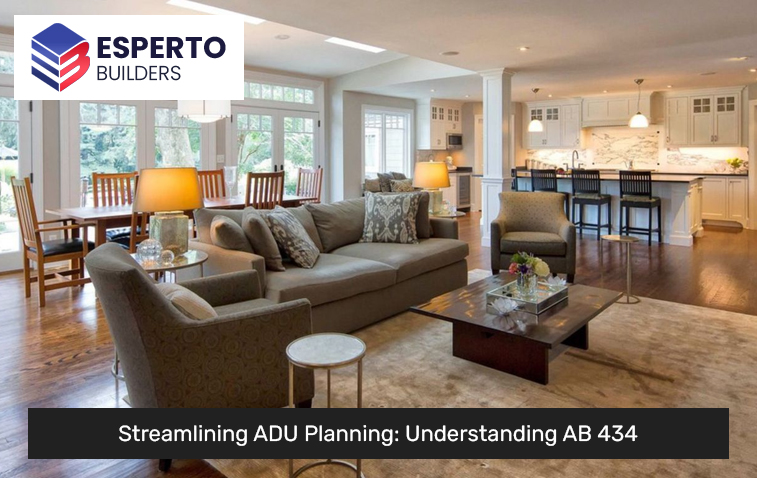Building a small home in your backyard might sound fun. These small homes are called Accessory Dwelling Units or ADUs. They can be great for family or renters. But making an ADU used to be hard. There were many rules to follow. Now, a new law called AB 434 makes it easier. This law helps people build ADUs faster. It cuts down on wait times and paperwork. AB 434 is changing how we think about ADUs. It’s making them more common in California. Whether you’re thinking about building an ADU or just curious, this information will help you understand the new rules.

AB 434 is a new law in California. It’s all about ADUs. But what exactly is it? Let’s break it down:
AB 434 is a big deal for anyone interested in ADUs. It makes the whole process simpler. Now, let’s look at why this law is so important.
California needed more homes. That’s where AB 434 came in. Here’s why it was made:
AB 434 was created to solve these problems. It aimed to make ADUs a real option for more people. The law wanted to cut down on red tape. It also wanted to speed up the building process.
AB 434 made big changes to ADU rules. Here are the main ones:
Faster Approvals:
Easier Parking Rules:
Size Matters:
Fewer Fees:
More Options:
These changes make a big difference. They open up new possibilities for homeowners. Let’s look at each change in more detail.
One of the biggest changes in AB 434 is the 60-day rule. Here’s how it works:
This rule is a game-changer. It stops cities from dragging their feet. It also gives homeowners more certainty. You know you’ll get an answer quickly. This makes planning much easier.
Parking used to be a big headache for ADU builders. AB 434 changed that:
These new rules make it much easier to build ADUs. You don’t need a big driveway or extra land. This opens up ADU options for more homeowners.
AB 434 lets you build bigger ADUs. Here’s what changed:
These new size rules give you more options. You can build an ADU that really fits your needs. It could be a home for grandparents or adult children. Or it could be a rental unit to earn extra income.
Building anything costs money. But AB 434 tries to keep ADU costs down:
This change makes ADUs more affordable. It removes a big barrier for many homeowners. Now, more people can consider building an ADU.
AB 434 introduces a new concept: Junior ADUs. Here’s what you need to know:
This gives homeowners even more flexibility. You could have a bigger ADU in the backyard. And you could also convert part of your house into a Junior ADU. This creates lots of options for multi-generational living or rental income.
AB 434 is a state law. But it affects different cities in different ways:
This means your experience might vary depending on where you live. But overall, AB 434 makes things easier everywhere in California.

Now that you know about AB 434, how do you plan an ADU? Here are some steps:
Check your property:
Learn your local rules:
Design your ADU:
Get your plans ready:
Submit your application:
Start building:
Planning an ADU takes time. But AB 434 makes the process smoother and faster.
AB 434 is changing California’s housing landscape. Here’s how:
The law is still new. But it’s already making a difference. More homeowners are considering ADUs. And more families are finding new housing options.
While AB 434 makes things easier, there are still challenges:
It’s important to think through these issues. AB 434 removes many barriers. But building an ADU is still a significant decision.
AB 434 is just the beginning. Here’s what might come next:
The future of ADUs in California looks bright. AB 434 has opened the door to new possibilities. It’s exciting to think about how our neighborhoods might change.
AB 434 has made big changes to ADU rules in California. It’s now easier and faster to build these small homes. The law cuts down on wait times and paperwork. It also allows for bigger ADUs and more flexible designs. This opens up new options for homeowners. Whether you want to house family members or earn rental income, ADUs are more accessible than ever. AB 434 is part of a bigger shift in how we think about housing. It encourages creative solutions to the housing shortage.
As more people learn about these new rules, we might see ADUs pop-up all-over California. This could change our neighborhoods in exciting ways. If you’re thinking about building an ADU, now might be the perfect time to start planning. The new rules make it easier than ever to turn your ADU dreams into reality.
Yes, you can build an ADU even if you’re in an HOA. AB 434 overrides many HOA restrictions on ADUs. However, the HOA may still have some say in design aspects. It’s best to check with your HOA board for specific rules.
In most cases, you don’t have to live on the property to build an ADU. AB 434 removed many owner-occupancy requirements. You can rent out both your main house and the ADU if you want to.
Generally, you can’t sell an ADU separately from the main house. ADUs are considered part of the primary property. However, some cities are exploring ways to allow ADU sales in the future.
While AB 434 doesn’t specify eco-friendly requirements, California has strict energy efficiency standards for new construction. Your ADU will need to meet these standards, which often results in a more eco-friendly building.